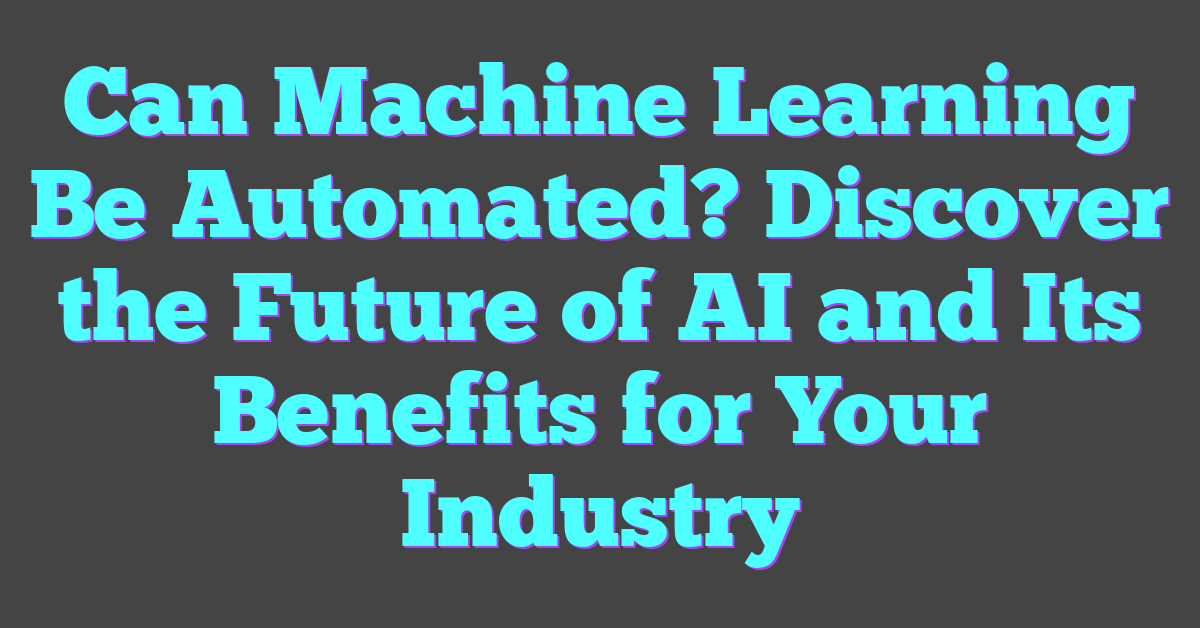In a world where technology evolves at lightning speed, the concept of automating machine learning sparks both excitement and curiosity. Imagine a system that not only learns from data but also improves its own learning processes without human intervention. This idea, once the realm of science fiction, is now inching closer to reality.
Machine learning automation promises to revolutionize industries by making data-driven decision-making more accessible and efficient. But can we truly automate something as complex and nuanced as machine learning? Exploring this question unveils a landscape filled with opportunities and challenges, pushing the boundaries of what we thought possible.
Exploring Automation in Machine Learning
Automating machine learning (ML) transforms how industries approach data-driven decision-making. This section delves into what ML automation entails and current technologies enabling this innovation.

What Is Machine Learning Automation?
Machine learning automation refers to the use of automated processes to streamline ML workflow components like data preprocessing, model selection, and hyperparameter tuning. By reducing manual intervention, it aims to make ML more accessible and efficient. Examples of automated steps include feature engineering, model training, and deployment.
Current Technologies Enabling Automation
Several technologies drive the automation of machine learning. AutoML frameworks like Google’s AutoML, Microsoft’s Azure Machine Learning, and Auto-Sklearn simplify the model development process. These tools allow users to build, train, and deploy models without deep ML expertise. Technologies like neural architecture search (NAS) optimize neural network structures, enhancing performance with minimal human input.
Benefits of Automating Machine Learning
Automating machine learning offers numerous advantages, particularly for enhancing and streamlining workflows. Two key benefits are accelerated model development and improved accuracy and efficiency.
Accelerated Model Development
Automation in machine learning accelerates model development by reducing manual tasks. Traditional model development involves various labor-intensive steps: data preprocessing, feature selection, and model evaluation. Automating these processes with tools like AutoML frameworks allows data scientists to focus more on problem-solving rather than mundane tasks. AutoML platforms can quickly test multiple models and select the best one, speeding up iterations and innovation. For instance, Google’s AutoML can build custom machine learning models in a fraction of the time compared to manual methods.
Improved Accuracy and Efficiency
Automated machine learning enhances accuracy by systematically optimizing hyperparameters and selecting the best models. Manual processes can lead to inconsistency and human error, while automation ensures consistent, reproducible results. AutoML platforms can explore numerous combinations and configurations, leading to more accurate predictions. Efficiency improves as automated systems handle large datasets and complex calculations more rapidly than humans. For example, DataRobot uses automation to rapidly prototype and deploy models, reducing time-to-value and operational costs.
Challenges in Machine Learning Automation
Automating machine learning offers significant advantages, but it also faces various challenges. Key areas of concern include the complexity of model interpretation and ethical and privacy issues.
Complexity of Model Interpretation
In machine learning automation, historical complexity in interpreting models can still pose challenges. Automated systems like AutoML often generate models through methods like neural architecture search, which may result in highly intricate models. Unlike traditional models with clear decision pathways, these complex models can become black boxes. This lack of transparency complicates understanding how predictions are made.
Interpreting complex models is crucial for verifying the decisions made by these systems. Professionals in fields like healthcare and finance need clear rationales behind model outputs to ensure reliability and trustworthiness. Frameworks for model interpretability, such as LIME and SHAP, have been developed to address this issue, but integrating these frameworks into automated systems remains a work in progress.
Ethical and Privacy Concerns
Machine learning automation raises ethical and privacy issues, significantly impacting data management and model deployment. Automation often requires extensive data, and ensuring this data’s ethical use is paramount. Data privacy regulations like GDPR and CCPA necessitate stringent compliance measures.
Automated systems must also avoid biases, which can be unintentionally introduced during the model training phase. Bias mitigation techniques are available, but their integration into automated systems is challenging. Ethical frameworks and audits need to be consistently applied to prevent misuse and ensure fairness.
Increased reliance on automation in machine learning magnifies the need to address these issues comprehensively. Ensuring that automated solutions respect ethical guidelines and privacy standards is essential for broader adoption and trust in these technologies.
Future of Automation in Machine Learning
The future of automation in machine learning (ML) shows promising growth and innovation. As ML technologies evolve, automation plays a pivotal role in enhancing capabilities and expanding applications across industries.
Emerging Trends and Innovations
New advancements are shaping the landscape of ML automation. AutoML frameworks are increasingly sophisticated, integrating more advanced algorithms and facilitating seamless operations. Emerging trends include:
- Explainable AI (XAI): Tools aiming to demystify ML models, creating transparency in automated systems.
- Federated Learning: Innovations allow models to train across decentralized data sets, preserving data privacy and improving robustness.
- Continuous Learning: Systems can now adapt and update models in real-time, without requiring a complete restart.
These innovations, combined with improving computational resources, ensure that automation continues pushing the boundaries of ML technology.
Potential Impact on Industries
Automation in ML has significant implications for multiple sectors. Key areas affected include:
- Healthcare: Automated ML models aid in diagnostics, predicting patient outcomes, and personalizing treatment plans. For instance, AI-driven diagnostics reduce time to diagnosis and improve accuracy.
- Finance: ML automates fraud detection, enhances risk management, and personalizes financial products. Systems like robo-advisors optimize investment strategies for individual clients.
- Retail: Automated predictive analytics improve inventory management, personalize customer experiences, and optimize pricing strategies.
Each industry witnessing automation in ML experiences reduced operational costs, enhanced decision-making, and improved efficiency. The integration ensures that companies remain competitive in a rapidly evolving market.
By focusing on these aspects, the article flows naturally into examining emerging trends and sector-specific impacts. This contextual approach maintains coherence and aligns with previous discussions on the benefits and challenges of ML automation.
Conclusion
The journey of automating machine learning is both promising and complex. While technologies like AutoML and Explainable AI are pushing the boundaries, it’s essential to address challenges around interpretability and ethics. As industries like healthcare and finance continue to benefit from these advancements, the focus should remain on balancing innovation with responsibility. With continuous improvements in computational resources and ethical frameworks, the future of machine learning automation looks bright and impactful.
Frequently Asked Questions
What are the key benefits of automating machine learning processes?
Automating machine learning processes offers accelerated model development, improved accuracy, and efficient handling of large datasets. Technologies like AutoML frameworks, including Google’s AutoML and DataRobot, enable these benefits by streamlining complex tasks and optimizing model performance.
What challenges arise from automated machine learning models?
One major challenge is model interpretability, as automated models can become opaque, making it difficult to understand their decision-making processes. Additionally, there are ethical concerns, such as potential biases embedded in these models, which need careful consideration and mitigation.
How can we address the ethical concerns in automated machine learning?
To address ethical concerns, integrating interpretability frameworks and adhering to ethical guidelines are crucial. These practices help ensure the reliability of automated models, promote transparency, and mitigate biases, making the models more trustworthy and compliant with regulations.
What are some emerging trends in the automation of machine learning?
Emerging trends include Explainable AI, which focuses on making AI decisions more transparent, Federated Learning, which enhances privacy by training models across decentralized data, and Continuous Learning, which allows models to improve over time with new data inputs.
How is automation in machine learning impacting various industries?
Automation in machine learning is transforming industries like healthcare, finance, and retail by reducing operational costs, enhancing decision-making processes, and improving efficiency. For example, it aids in early disease detection in healthcare, fraud detection in finance, and personalized marketing in retail.
What role do improved computational resources play in ML automation?
Improved computational resources are crucial for advancing ML automation as they enable the processing of larger datasets, faster model training, and the implementation of complex algorithms, driving innovation and efficiency in machine learning applications.




